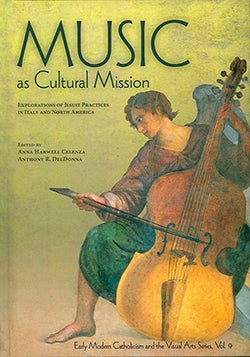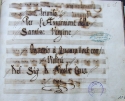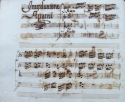Introduction:

Numerous scholars have documented the considerable history of the Jesuit commitment to the cultivation of music and closely related fields, especially theatre. The volume Music as Cultural Mission: Explorations of Jesuit Practices in Italy and North America, edited by Professors Anna Harwell Celenza and Anthony DelDonna, attempts to build on previous scholarship in the realm of musicology and Jesuit studies and, in so doing, explore myriad ways in which music, theater, and scholarship have played a role in what John O’Malley, S.J. has defined as the Jesuit cultural mission.
Although not explicitly outlined in the foundational documents of the Society of Jesus, the cultural mission played a defining role in the growth and subsequent expansion of the Order, most notably in the realms of education and missionary outreach. This book explores various practices developed by the Society of Jesus as part of its cultural mission. Instead of focusing on the Society’s origins, the various narratives in this book begin at least a century later and explore various ways in which music and theater functioned within the Society’s educational and evangelical vocations. As preachers, teachers, scholars, and missionaries, the Jesuits connected with the outside world and spread the Word of God through music. This was an important part of what they called “our way of proceeding” (noster modus procedendi).
Title page to Pedro A. Daunas' Philodemic Grand March (1854)
Pedro A. Daunas was appointed as Professor of Music at Georgetown in 1850 and also served as the university’s first organist. Daunas believed that learning to perform music strengthened a young man’s rhetorical skills and composed the Philodemic Grand March for the school’s debating club.
La Hermandad, A Sett of Favorite Spanish Waltzes (1834) by Pedro A. Daunas
Daunas composed La Hermandad, a set of character pieces for solo piano, for the all-girls Academy of Visitation, next to the Georgetown campus. Each of the pieces bears the name of a student and attempts to portray their personality.
The Georgetown Banjo-Mandolin Club in 1896
The 1890s witnessed the growth of numerous student music groups of different types. Among the most popular were the Mandolin, Banjo, and Glee Clubs, which on occasion collaborated together. The music performed by these groups was always contemporary and often described in The Georgetown Journal.
“Rose of Delta Sig,” dedicated to the Mu Chapter at Georgetown University, by Paul H. Coughlin (Washington, DC: DeForce & Coughlin Publishers, 1924)
The large collection of contemporary music in the archives, often in the vein of “Tin Pan Alley,” reflected the numerous student club activities on campus and fundraisers including annual dances. Paul Coughlin graduated in 1927 and received the John Carroll Award from Georgetown in 1957. He had a long career in the defense industry in Washington, D.C.
Paul Claudel, French Ambassador to the US (left), Georgetown President Coleman Nevils, S.J. (middle) and Arturo Toscanini (right) after the Founder’s Day celebration at Georgetown University on March 25, 1930
On March 25, 1930, Georgetown revived the tradition of bestowing honorary doctoral degrees in music. President Coleman Nevils, S.J. presented the degree to Arturo Toscanini, the principal conductor of La Scala Opera House in Milan and a frequent conductor of the New York Philharmonic Orchestra. The degree was presented on Founder’s Day and read “to the greatest master of music in modern times.”
Nicolò Ceva, Trionfo per l’Assunzione della Santissima Vergine, 1705 Premiered Naples, Seminario dei Nobili (Jesuit College)
Trionfo per l’Assunzione della Santissima Vergine is an oratorio (a sacred drama) for four vocal soloists and string ensemble composed for the Feast of the Assumption in 1705 celebrated on August 15th each year, marking the ascension of the Blessed Virgin Mary to Paradise. It was performed by students and professional musicians and sponsored by a Marian sodality, the Congregazione dei Mercanti (or Congregation of Merchants) at the principal Jesuit school of Naples, the Seminario dei Nobili.
The composer Ceva was a priest (not a Jesuit) and among the musical elite of early eighteenth-century Naples. The manuscript was recovered in Naples in 2008, where it had resided uncatalogued presumably since the eighteenth century. It can be assumed that the hand of the manuscript is that of Ceva.
From the Library of the Conservatory of Naples, San Pietro a Majella.
Used by kind permission.
Curated by Anthony R. DelDonna and Anna Harwell Celenza.
Assisted by John Buchtel, Lynn Conway, and Stephanie Hughes.
Photography by David Hagen.
In conjunction with the Friday Music Series performance "Music as Cultural Mission: Explorations of Jesuit Practices" on Friday, September 19, 2014.







